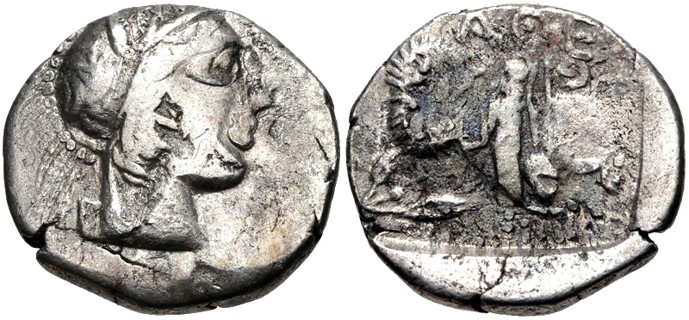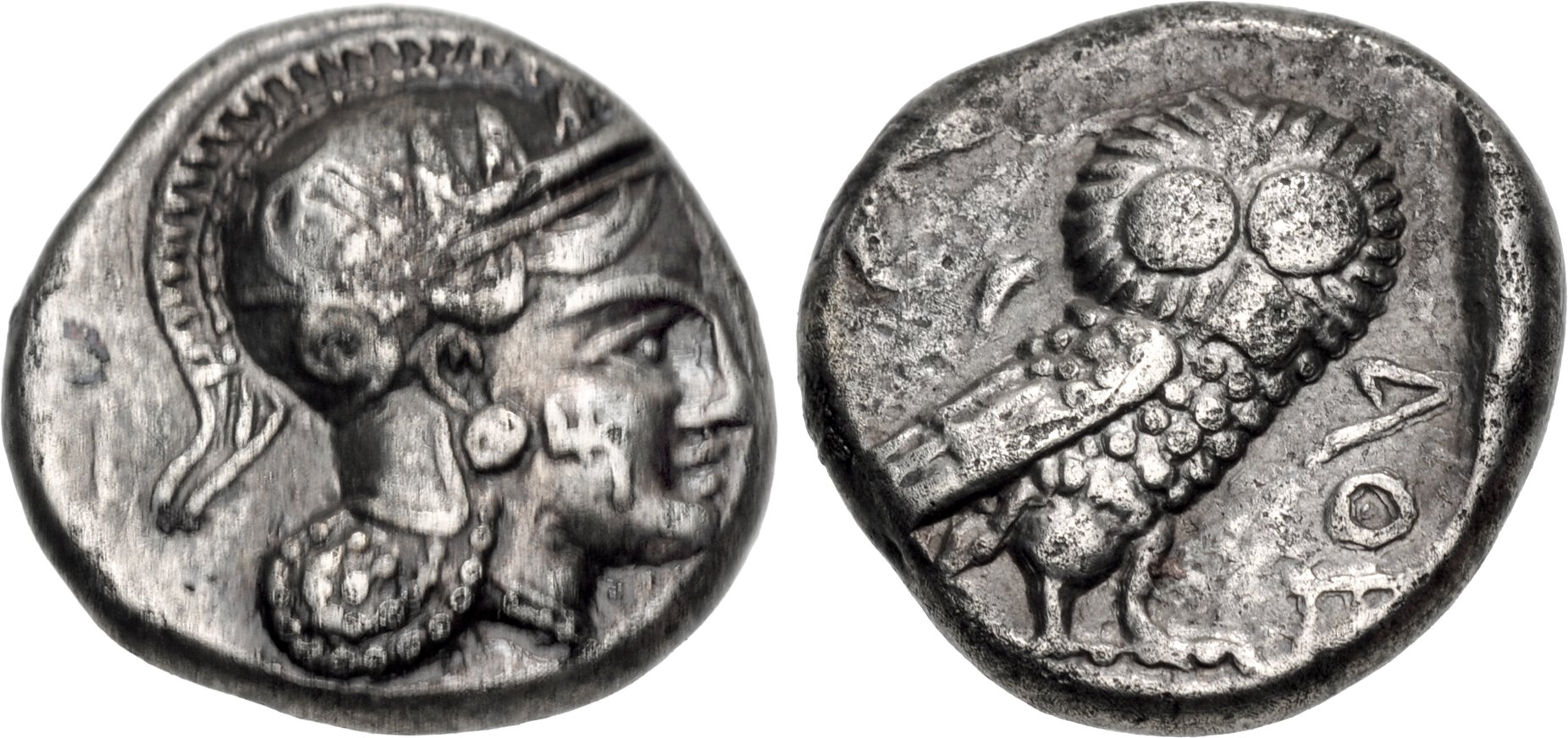2466 - Eusebeia (Ariobarzanes III) (drachma Ariobarzanes/Nike) over Athenian imitation (CNG, EA 401, July 2017, 198)
From SILVER
52 BCE - 42 BCE
Location/history
| Sale(s)Sale(s) ᵖ: | Classical Numismatic Group, EA 401, 12 July 2017, 198 | |
Overstriking coin
Description
| ObverseInscription or printing placed on the obverse.: | Head right, wearing diadem. | ReverseInscription or printing placed on the reverse.: | Athenan Nikephoros standing left. |
Mint and issuing power
| MintIdentifies the place of manufacture or issue of a numismatic object.: | Eusebeia | Ancient regionAncient region. | Cappadocia | Modern countryModern country: Turkey | AuthorityIdentifies the issuing power. The authority can be "pretended" when the name or the portrait of X is on the coin but he/she was not the issuing power. It can also be "uncertain" when there is no mention of X on the coin but he/she was the issuing power according to the historical sources: | Cappadocian kingdom, Ariobarzanes III of Cappadocia (51-42 BCE) |
Chronology
| FromIdentifies the initial date in a range assigned in a numismatic context. 52 BCE toIdentifies the final date in a range assigned in a numismatic context.. 42 BCE | Hellenistic 323-30 BC |
Physical description
| MetalThe physical material (usually metal) from which an object is made.: Silver |
WeightWeight of the numismatic object (in grams). in grams: 3.543.54 g <br />3,540 mg <br /> | DenominationTerm indicating the value of a numismatic object. Examples: tetradrachm, chalkous, denarius.: drachma |
AxisDescribes the directional relationship between the obverse and reverse of a numismatic object.: 1212 mm <br />1.2 cm <br /> |
| DiameterDescribes diameter of an object (in mm).: 16.516.5 mm <br />1.65 cm <br /> | |||
References
| Coin referenceReference of the Coin: | Coin series referenceReference to coin series study: | HGC 71HGC 7, n° 853 |
Overstruck type
Description
| ObverseInscription or printing placed on the obverse.: | Helmeted head of Athena right, with profile eye and pi-style palmette, Aramaic M horizonally on cheek | ReverseInscription or printing placed on the reverse.: | Owl standing right, head facing, olive spray and crescent to left, all within shallow incuse square. |
Mint and issuing power
| MintIdentifies the place of manufacture or issue of a numismatic object. ᵖ: | Gaza | Ancient regionAncient region. ᵖ | Judaea | Modern countryModern country: Palestine | AuthorityIdentifies the authority in whose name (explicitly or implicitly) a numismatic object was issued. ᵖ: |
Chronology
| FromIdentifies the initial date in a range assigned in a numismatic context. 353 BCE toIdentifies the final date in a range assigned in a numismatic context.. 200 BCE | Hellenistic 323-30 BC |
Physical description
| DenominationTerm indicating the value of a numismatic object. Examples: tetradrachm, chalkous, denarius. ᵖ: | drachma |
References
| Coin type referenceReference to coin series study ᵖ: | HGC 102HGC 10, n° 542 |
Additional data
| Frequency of overstrikesFrequency of overstrikes: | exceptional | Level of confidenceLevel of confidence of the identification: | weak |
| RemarksRemarks: | "overstruck on an eastern imitation of Athens. Numismatically important. The attribution of this coin to Ariobarzanes III is based on the hair that is visible behind the ear on the portrait (most of which is not struck up). Such a series of forward swept hair in this location is only known on coins of this king (such as in the illustration of HGC 7, 853). The wide space between the legends and Athena on the reverse is also indicative of the last two Cappadocian kings, so if it not Ariobarzanes, it would almost certainly be his successor, Ariarathes X. The undertype is almost certainly an eastern imitation of Athens, as the style of the elements visible are not consistent with official products of that city" (nb: the attribution to Gaza is highly speculative) | ||
References
- ^ Hoover, Oliver D. (2012), Handbook of Greek Coinages. 7. Coins of northern and Central Anatolia - Pontos, Paphlagonia, Bithynia, Phrygia, Galatia, lykaonia, and Kappadokia (with Kolchis and the Kimmerian bosporos), Lancaster, lxxxii, 352 p. : ill. ; 23 cm.
- ^ Hoover, Oliver D. (2010), The Handbook of Greek Coinage Series. 10. handbook of coins of the Southern Levant : Phoenicia, southern Koile Syria (including Judaea), and Arabia, Lancaster-London, lxxix, 201 p.

